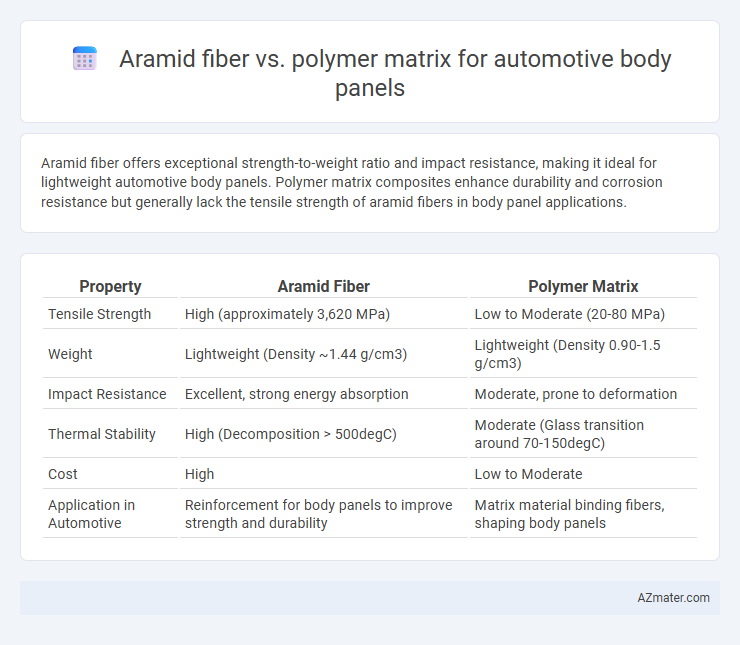Aramid fiber offers exceptional strength-to-weight ratio and impact resistance, making it ideal for lightweight automotive body panels. Polymer matrix composites enhance durability and corrosion resistance but generally lack the tensile strength of aramid fibers in body panel applications.
Table of Comparison
| Property | Aramid Fiber | Polymer Matrix |
|---|---|---|
| Tensile Strength | High (approximately 3,620 MPa) | Low to Moderate (20-80 MPa) |
| Weight | Lightweight (Density ~1.44 g/cm3) | Lightweight (Density 0.90-1.5 g/cm3) |
| Impact Resistance | Excellent, strong energy absorption | Moderate, prone to deformation |
| Thermal Stability | High (Decomposition > 500degC) | Moderate (Glass transition around 70-150degC) |
| Cost | High | Low to Moderate |
| Application in Automotive | Reinforcement for body panels to improve strength and durability | Matrix material binding fibers, shaping body panels |
Introduction to Automotive Body Panel Materials
Aramid fiber and polymer matrix materials are fundamental in manufacturing automotive body panels due to their exceptional strength-to-weight ratios and impact resistance. Aramid fibers, known for their high tensile strength and thermal stability, enhance durability and safety in vehicle structures, while polymer matrices provide lightweight flexibility and corrosion resistance essential for modern automotive design. Combining aramid fibers with polymer matrices results in composite materials that significantly improve fuel efficiency and crashworthiness in automotive body panels.
Overview of Aramid Fiber Properties
Aramid fiber exhibits exceptional tensile strength, high toughness, and superior impact resistance, making it an ideal reinforcement material for automotive body panels. Its low density contributes to lightweight structures, enhancing fuel efficiency without compromising durability. Aramid's outstanding thermal stability and resistance to chemical corrosion ensure long-term performance in demanding automotive environments.
Key Characteristics of Polymer Matrix Materials
Polymer matrix materials in automotive body panels offer high corrosion resistance and excellent lightweight properties, enhancing fuel efficiency and vehicle performance. Their inherent flexibility and impact absorption improve crashworthiness while enabling complex shapes and design versatility. Thermosetting epoxies and thermoplastics dominate as polymer matrices, providing thermal stability, chemical resistance, and ease of manufacturing in composite automotive structures.
Strength and Durability: Aramid Fiber vs Polymer Matrix
Aramid fiber offers exceptional tensile strength and impact resistance compared to traditional polymer matrices, making it highly effective for automotive body panels that require enhanced durability. The high strength-to-weight ratio of aramid fibers significantly improves panel rigidity while maintaining lightweight properties crucial for vehicle efficiency. Polymer matrices, although providing good flexibility and corrosion resistance, generally lack the superior durability and fatigue resistance exhibited by aramid fiber-reinforced composites under mechanical stress.
Lightweight Performance Comparison
Aramid fibers exhibit superior tensile strength-to-weight ratios compared to polymer matrices, making them ideal for lightweight automotive body panels that demand high impact resistance and durability. Polymer matrices, while providing structural flexibility and ease of molding, generally add more weight and offer lower mechanical performance under stress. Utilizing aramid fiber-reinforced composites results in significant weight reduction and enhanced crashworthiness, contributing to improved fuel efficiency and vehicle handling.
Impact Resistance and Safety Considerations
Aramid fiber offers superior impact resistance for automotive body panels due to its high tensile strength and energy absorption capabilities, enhancing occupant safety during collisions. Polymer matrices, while providing lightweight and corrosion-resistant properties, generally exhibit lower impact resistance, potentially compromising structural integrity under severe impact conditions. Combining aramid fiber with advanced polymer matrices creates composite materials that optimize both impact resistance and safety performance in automotive body structures.
Thermal Stability Under Automotive Conditions
Aramid fibers exhibit superior thermal stability compared to polymer matrices when used in automotive body panels, maintaining mechanical integrity and resistance to thermal degradation at elevated temperatures typical of engine compartments and external environments. Polymer matrices, such as epoxy or polyester resins, often degrade or lose stiffness above 150degC, whereas aramid fibers can withstand temperatures exceeding 300degC without significant loss of strength. This thermal resilience of aramid fibers enhances the durability and safety of automotive body panels under harsh operating conditions.
Manufacturing Processes and Cost Implications
Aramid fiber reinforced composites for automotive body panels offer superior strength-to-weight ratios compared to traditional polymer matrix materials, enhancing durability and impact resistance. Manufacturing processes for aramid fibers typically involve complex handling and specialized resin impregnation techniques, increasing production time and cost relative to conventional polymer matrices like polypropylene or fiberglass composites. Cost implications include higher raw material expenses and labor-intensive fabrication, but these are often offset by improved vehicle performance and potential weight reduction benefits leading to fuel efficiency.
Environmental Sustainability and Recycling Options
Aramid fiber reinforced composites offer high strength-to-weight ratios for automotive body panels, enhancing fuel efficiency and reducing CO2 emissions during vehicle operation. Polymer matrix materials, typically thermoset resins, present challenges in recycling due to cross-linking, whereas emerging thermoplastic matrices enable improved recyclability and lower environmental impact. Sustainable automotive design increasingly favors thermoplastic polymer matrices combined with aramid fibers to balance performance with end-of-life material recovery and circular economy goals.
Future Trends in Automotive Body Panel Materials
Aramid fiber composites offer superior impact resistance and lightweight strength compared to traditional polymer matrix materials, making them a promising choice for future automotive body panels aimed at enhancing safety and fuel efficiency. Advancements in hybrid materials combining aramid fibers with thermoplastic polymer matrices are driving innovations toward recyclable, durable, and high-performance panels. Emerging trends emphasize sustainable manufacturing processes and improved material recyclability, aligning with automotive industry goals for reduced emissions and enhanced vehicle longevity.

Infographic: Aramid fiber vs Polymer matrix for Automotive body panel
 azmater.com
azmater.com